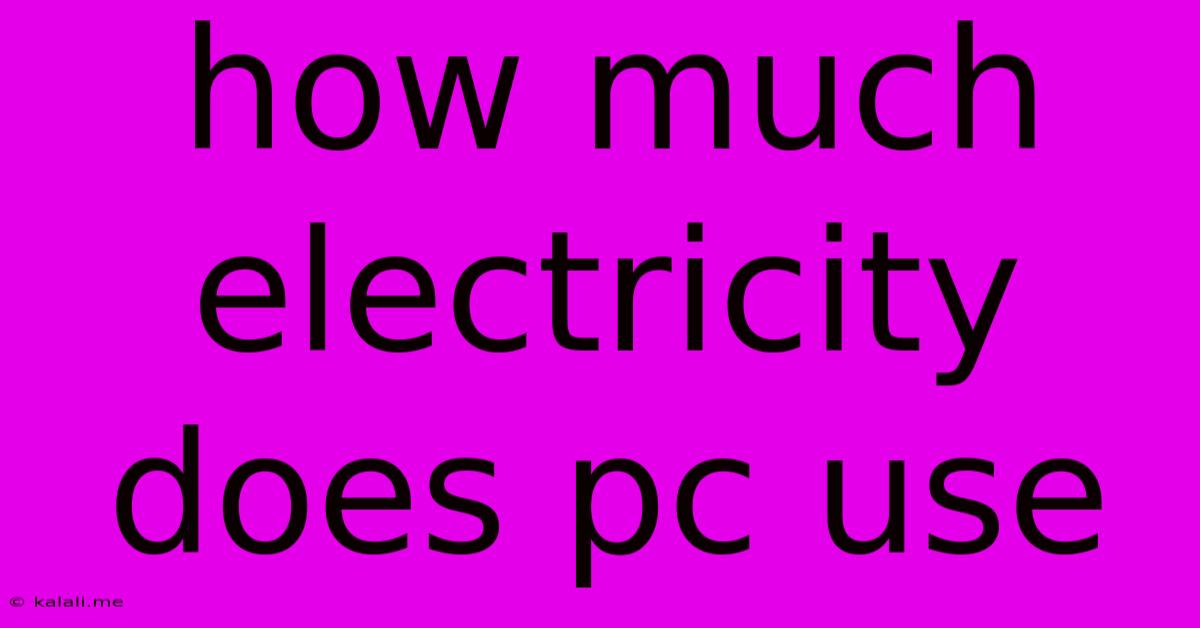How Much Electricity Does Pc Use
Kalali
May 21, 2025 · 4 min read

Table of Contents
How Much Electricity Does a PC Use? A Comprehensive Guide
Meta Description: Wondering about your PC's energy consumption? This guide breaks down how much electricity a PC uses, factors affecting power draw, and ways to reduce your energy footprint. Learn how to calculate your PC's energy costs and make informed choices about your hardware.
Powering your desktop computer is more than just plugging it in; it's a significant contributor to your overall energy consumption, especially if you're a gamer, video editor, or cryptocurrency miner. Understanding how much electricity your PC uses is crucial not only for managing your energy bills but also for making environmentally conscious choices. This comprehensive guide breaks down the factors affecting your PC's power draw and offers tips on reducing its energy consumption.
Factors Affecting PC Electricity Consumption
Several components and usage patterns determine how much electricity your PC consumes. Here's a breakdown of the key factors:
-
Components: The most significant contributors to your PC's power consumption are your CPU (Central Processing Unit), GPU (Graphics Processing Unit), and power supply unit (PSU). High-end, overclocked components, particularly GPUs used for gaming or demanding tasks like video rendering, draw significantly more power than their entry-level counterparts. Even storage devices like hard disk drives (HDDs) and solid-state drives (SSDs) consume power, though in much smaller amounts.
-
Usage: The intensity of your computer's workload directly correlates with its power consumption. Idle systems use significantly less electricity than systems running demanding applications like games, video editing software, or 3D rendering programs. Background processes and numerous open applications also increase your PC's power draw.
-
Monitor: Your monitor consumes a considerable amount of electricity, especially larger, higher-resolution displays. Consider the power consumption specifications of your monitor when assessing your overall system's energy usage.
-
Peripherals: External devices connected to your PC, such as printers, external hard drives, and speakers, all contribute to its overall power consumption, though usually to a lesser extent than the main components.
Measuring Your PC's Electricity Consumption
There are several ways to measure your PC's electricity usage:
-
Power Meter: A kilowatt-hour (kWh) meter is the most accurate way to measure your PC's energy consumption. These devices plug into the wall and then your PC plugs into the meter. They display real-time power usage and can track cumulative energy consumption over time.
-
Software Monitoring Tools: Many software applications can monitor your PC's power usage, offering real-time data and insights into individual component power draw. While these tools provide estimates, they can be useful for comparing power usage under different workloads.
-
Power Supply Label: Your PSU usually has a label indicating its maximum power output (in watts). While this doesn't represent your PC's average power consumption, it provides an upper limit.
Calculating Your PC's Energy Costs
Once you've determined your PC's average power consumption (in watts or kilowatts), you can calculate your energy costs:
- Convert watts to kilowatts: Divide the wattage by 1000.
- Calculate daily consumption: Multiply your kilowatts by the number of hours your PC is used daily.
- Calculate monthly consumption: Multiply your daily consumption by 30 (or the number of days in the month).
- Calculate cost: Multiply your monthly consumption by your electricity rate (per kWh).
Reducing Your PC's Energy Consumption
There are several effective strategies to reduce your PC's energy footprint and save money:
- Lower Screen Brightness: Reducing your monitor's brightness significantly reduces energy consumption.
- Turn Off Unused Peripherals: Unplug devices you aren't actively using.
- Enable Power Saving Modes: Configure your operating system and applications to use power-saving modes.
- Choose Energy-Efficient Components: Opt for energy-efficient components when building or upgrading your PC. Look for components with lower TDP (Thermal Design Power) ratings.
- Regular Maintenance: Keep your PC clean and free of dust to ensure efficient cooling and optimal performance, thereby reducing power draw.
- Sleep Mode vs. Shutdown: While sleep mode consumes some power, it's often more energy-efficient than a full shutdown and restart, particularly for frequently used PCs.
By understanding the factors influencing your PC's electricity consumption and implementing energy-saving strategies, you can significantly reduce your energy bills and contribute to a greener environment. Remember to regularly monitor your power usage to stay informed and adapt your habits as needed.
Latest Posts
Latest Posts
-
Can You Drink The Tap Water In France
May 21, 2025
-
London St Pancras To Euston Station
May 21, 2025
-
How Long Does Hot Water Take To Heat Up
May 21, 2025
-
Difference Between Ham Pork And Bacon
May 21, 2025
-
Flip A Coin And Roll A Die
May 21, 2025
Related Post
Thank you for visiting our website which covers about How Much Electricity Does Pc Use . We hope the information provided has been useful to you. Feel free to contact us if you have any questions or need further assistance. See you next time and don't miss to bookmark.